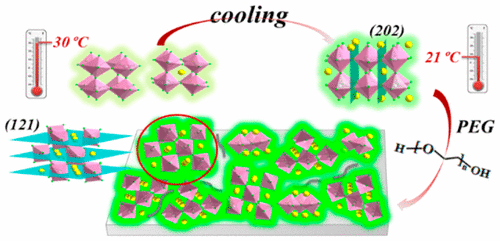当前位置:
X-MOL 学术
›
ACS Appl. Mater. Interfaces
›
论文详情
Our official English website, www.x-mol.net, welcomes your
feedback! (Note: you will need to create a separate account there.)
Controlling Crystallization of All-Inorganic Perovskite Films for Ultralow-Threshold Amplification Spontaneous Emission
ACS Applied Materials & Interfaces ( IF 8.3 ) Pub Date : 2017-09-19 00:00:00 , DOI: 10.1021/acsami.7b10863 Zi-Jun Yong 1 , Yang Zhou 1 , Ju-Ping Ma 1 , Ya-Meng Chen 1 , Jun-Yi Yang 2 , Ying-Lin Song 2 , Jing Wang 3 , Hong-Tao Sun 1
ACS Applied Materials & Interfaces ( IF 8.3 ) Pub Date : 2017-09-19 00:00:00 , DOI: 10.1021/acsami.7b10863 Zi-Jun Yong 1 , Yang Zhou 1 , Ju-Ping Ma 1 , Ya-Meng Chen 1 , Jun-Yi Yang 2 , Ying-Lin Song 2 , Jing Wang 3 , Hong-Tao Sun 1
Affiliation

|
All-inorganic lead halide perovskites have gained considerable interest owing to their potential applications in an array of high-performance optoelectronic devices. However, producing highly luminescent, nearly pinhole-free, all-inorganic perovskite films through a simple solution process remains challenging. Here, we provide a detailed investigation of the crystallization control of inorganic perovskite films fabricated by a one-step spin-coating process. Our results reveal that the coating temperature in the fabrication process is of paramount importance in influencing perovskite crystallization and that lowering the coating temperature and fine stoichiometry modification of the precursors favor the suppression of trap states in CsPbBr3 perovskite films. A broad range of experimental characterizations help us identify that nonsynergistic assembly of solutes, resulting from poor diffusion capability of inorganic salts, is the dominant cause for the inhomogeneous element distribution, low luminescence yield, and poor surface coverage of the resulting films. Importantly, we find that polyethylene glycol can also be used for tailoring the crystallization process, which enables the attainment of high-quality CsPbBr3 films with a maximum luminescence yield of ∼30%. Finally, we demonstrate that amplification spontaneous emission with an ultralow threshold can be readily accomplished by using the developed film as an emissive component. Our findings provide deep insights into the crystallization control of CsPbBr3 perovskite films and establish a systematic route to high-quality all-inorganic perovskite films, paving the way for widespread optoelectronic applications.
中文翻译:

控制超低阈值放大自发发射的全无机钙钛矿薄膜的结晶
全无机卤化铅钙钛矿由于在一系列高性能光电器件中的潜在应用而引起了人们的极大兴趣。然而,通过简单的溶液制备方法来生产高亮度,几乎无针孔的全无机钙钛矿薄膜仍然具有挑战性。在这里,我们提供了通过一步旋涂工艺制备的无机钙钛矿薄膜结晶控制的详细研究。我们的结果表明,制造过程中的涂层温度对于影响钙钛矿的结晶至关重要,降低涂层温度和对前体进行精细的化学计量修饰有助于抑制CsPbBr 3中的陷阱态。钙钛矿膜。广泛的实验表征帮助我们确定,由于无机盐的扩散能力差而导致的溶质的非协同组装,是导致元素分布不均匀,发光产率低和所得膜的表面覆盖率差的主要原因。重要的是,我们发现聚乙二醇也可用于调整结晶过程,从而能够获得高质量的CsPbBr 3薄膜,最大发光率约为30%。最后,我们证明通过使用显影的薄膜作为发射组件可以轻松实现具有超低阈值的放大自发发射。我们的发现为CsPbBr 3的结晶控制提供了深刻的见解。 钙钛矿薄膜,并建立了生产高质量全无机钙钛矿薄膜的系统途径,为广泛的光电应用铺平了道路。
更新日期:2017-09-19
中文翻译:

控制超低阈值放大自发发射的全无机钙钛矿薄膜的结晶
全无机卤化铅钙钛矿由于在一系列高性能光电器件中的潜在应用而引起了人们的极大兴趣。然而,通过简单的溶液制备方法来生产高亮度,几乎无针孔的全无机钙钛矿薄膜仍然具有挑战性。在这里,我们提供了通过一步旋涂工艺制备的无机钙钛矿薄膜结晶控制的详细研究。我们的结果表明,制造过程中的涂层温度对于影响钙钛矿的结晶至关重要,降低涂层温度和对前体进行精细的化学计量修饰有助于抑制CsPbBr 3中的陷阱态。钙钛矿膜。广泛的实验表征帮助我们确定,由于无机盐的扩散能力差而导致的溶质的非协同组装,是导致元素分布不均匀,发光产率低和所得膜的表面覆盖率差的主要原因。重要的是,我们发现聚乙二醇也可用于调整结晶过程,从而能够获得高质量的CsPbBr 3薄膜,最大发光率约为30%。最后,我们证明通过使用显影的薄膜作为发射组件可以轻松实现具有超低阈值的放大自发发射。我们的发现为CsPbBr 3的结晶控制提供了深刻的见解。 钙钛矿薄膜,并建立了生产高质量全无机钙钛矿薄膜的系统途径,为广泛的光电应用铺平了道路。











































 京公网安备 11010802027423号
京公网安备 11010802027423号